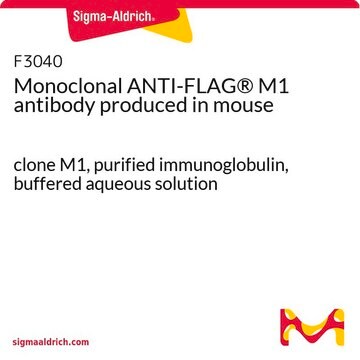A9594
Anticorpo monoclonale ANTI-FLAG® M2
clone M2, purified immunoglobulin, buffered aqueous solution (Supplied as a solution in 10 mM sodium phosphate)
Sinonimo/i:
Anti-ddddk, Anti-dykddddk
About This Item
Prodotti consigliati
Origine biologica
mouse
Coniugato
CY3 conjugate
Forma dell’anticorpo
purified immunoglobulin
Tipo di anticorpo
primary antibodies
Clone
M2, monoclonal
Forma fisica
buffered aqueous solution (Supplied as a solution in 10 mM sodium phosphate)
Reattività contro le specie
all
Concentrazione
~1 mg/mL
tecniche
direct immunofluorescence: 10 μg/mL using mammalian cells fixed with methanol:acetone
Isotipo
IgG1
Sequenza immunogenica
DYKDDDDK
Condizioni di spedizione
dry ice
Temperatura di conservazione
−20°C
Cerchi prodotti simili? Visita Guida al confronto tra prodotti
Descrizione generale
Applicazioni
Western Blotting (1 paper)
Learn more product details in our FLAG® application portal.
Stato fisico
Nota sulla preparazione
Altre note
Note legali
Not finding the right product?
Try our Motore di ricerca dei prodotti.
Codice della classe di stoccaggio
10 - Combustible liquids
Punto d’infiammabilità (°F)
Not applicable
Punto d’infiammabilità (°C)
Not applicable
Certificati d'analisi (COA)
Cerca il Certificati d'analisi (COA) digitando il numero di lotto/batch corrispondente. I numeri di lotto o di batch sono stampati sull'etichetta dei prodotti dopo la parola ‘Lotto’ o ‘Batch’.
Possiedi già questo prodotto?
I documenti relativi ai prodotti acquistati recentemente sono disponibili nell’Archivio dei documenti.
I clienti hanno visto anche
Il team dei nostri ricercatori vanta grande esperienza in tutte le aree della ricerca quali Life Science, scienza dei materiali, sintesi chimica, cromatografia, discipline analitiche, ecc..
Contatta l'Assistenza Tecnica.

















